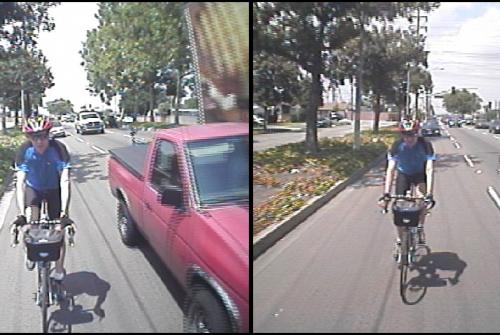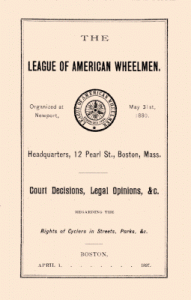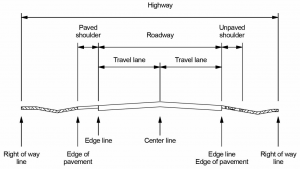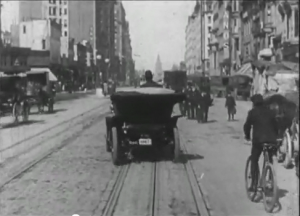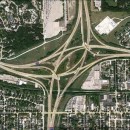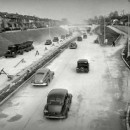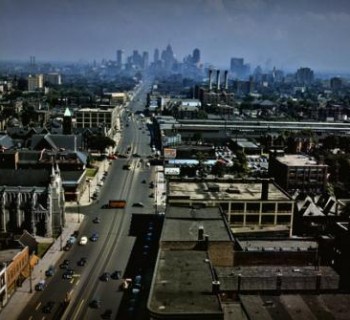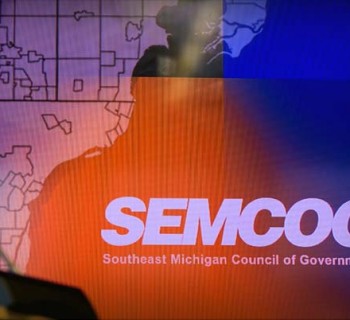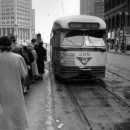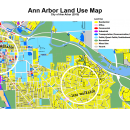Source: Bob Shanteau
Editor's Note: This article was originally featured on IAmTraffic.org and is reposted with permission.
Not long ago I was riding in the middle of the right-hand (slow) lane on a 4-lane urban street with parallel parking and a 25 mph speed limit. I had just stopped at a 4-way stop when the young male driver of a powerful car in the left lane yelled at me, “You ain't no f***ing car man, get on the sidewalk.” He then sped away, cutting it close as he changed lanes right in front of me in an attempt, I suppose, to teach me a lesson.
That guy stated in a profane way the world view of most people today: If you can't keep up, stay out of the way. My being in the right-hand lane and therefore “in his way” violated his sense that roads in general and travel lanes in particular are only for cars, a viewpoint that I call the car lane paradigm. The car lane paradigm conflicts with the fact that in every state of the union, bicyclists have the same rights and duties as drivers of vehicles.
So which is it? Do bicyclists have the same right to use travel lanes as other drivers or not? Before lanes existed, bicyclists simply acted like other drivers. But now that travel lanes are common, most people grow up with the car lane paradigm with bicyclists relegated to the margins of the road. This article goes into the history of how the car lane paradigm came to be and what we can do about it now.
Reading this is going to take a while, so here is an outline of where we're going:
- 1897: In the beginning, bicycles were vehicles and bicyclists were drivers
- 1930: Bicycles are not vehicles
- 1911 – now:
- Lane lines are invented and become common. Oops, the inventors of lane lines forgot about bicycles
- “Slower Traffic Keep Right” or “Slower Traffic Use Right Lane”?
- What does the “or” in “right-hand lane or as close as practicable to the right” mean?
- Do speed and might mean that travel lanes are actually “car lanes”?
- 1944: If you can't keep up, you don't belong (in the lane)
- 1968: Motorcyclists, but not bicyclists, are entitled to full use of a lane
- 1975: Bicycles once again defined as vehicles, but still not entitled to the use of a full lane
- Exceptions to the law requiring bicyclists to ride far right are better than nothing, right?
- Now: No room on the road for bicycles
- Bicycles at the far right and laned roads are incompatible
- What do we do now?
In the beginning, bicycles were vehicles and bicyclists were drivers
In 1789, the United States Constitution delegated to the states the power of policing their own citizens, including the power to establish their own rules of the road. As it turns out, some states even allow local agencies to have their own rules of the road. Since it is impractical to go over the history of every set of rules of the road in the U.S., this article will for the most part focus on events at the national level.
As the bicycle became popular in the late 1800′s, some states and local agencies adopted laws prohibiting bicycles on their roads. By 1897 the League of American Wheelmen had successfully challenged those laws and declared in a pamphlet:
The League has made it possible for a cycler to ride the wheel on any street or highway in the United States. When the League was formed the bicycle had no legal recognition; now it is universally recognized as a carriage, and may travel with impunity wherever any carriage does.1
Some foresighted people saw that it was necessary to formally organize the laws applying to road users into what came to be called “rules of the road.” One of the first places where rules of the road were adopted in the U.S. was New York City in 1903 2. In those first rules of the road, bicycles were defined as vehicles, the operators of which were treated the same as operators of other vehicles (most of which were horse-drawn wagons and carriages).
Rules for driving on an unlaned road – drive on right half, pass on left, slower vehicles as far right as practicable Many of those early rules of the road are familiar to us even today: drive on the right side of the road, slower traffic keep right, overtake on the left, don't go faster than is safe, turn left from the center of the road, turn right from the far right, etc.
But there were variations in the rules of the road adopted by the various states and localities, which eventually led to an effort to create a model for the rules of the road for all the states and local agencies to follow. In 1926, the Uniform Vehicle Code was created by what came to be known as the National Committee on Uniform Traffic Laws and Ordinances. 3 States are encouraged to adopt the provisions of the UVC as their own, with some complying more than others.
The original 1926 UVC incorporated the victory won by the LAW when it defined a bicycle as a vehicle: “Vehicle.”
Every device in, upon or by which any person or property is or may be transported or drawn upon a public highway, excepting devices moved by human power or used exclusively upon stationary rails or tracks; provided, that for the purposes of (Title II of) this act, a bicycle or a ridden animal shall be deemed a vehicle.
For bicyclists, defining bicycles as vehicles was crucial, not least because two of the most important provisions of the UVC are the definitions of “highway” and “roadway,” which in turn use the term “vehicular travel”:
Typical rural two-lane highway showing definitions of highway, roadway, travel lane and shoulder
Section 1. Definitions “Highway.” Every way or place of whatever nature open to the use of the public, as a matter of right, for purposes of vehicular travel. The term “highway” shall not be deemed to include a roadway or driveway upon grounds owned by private persons, colleges, universities or other institutions.
Notice that the definition of “highway” said nothing about speed, so the roads were just as open to the drivers of slower vehicles as to faster vehicles. That slower vehicles are normal was reinforced by the law requiring drivers of slower vehicles to keep right:
A police officer on a bicycle citing a motorist in New York City. William Phelps Eno, Street Traffic Regulation, 1909
Section 10. Drive on Right Side of Highway. …Upon all highways of sufficient width, except upon one way streets, the driver of a vehicle shall drive the same upon the right half of the highway and shall drive a slow moving vehicle as closely as possible to the right-hand edge or curb of such highway, unless it is impracticable to travel on such side of the highway and except when overtaking and passing another vehicle subject to the limitations applicable in overtaking and passing set forth in Sections 13 and 14 of this act.
The UVC also addressed overtaking:
Section 13. Overtaking a Vehicle.
(a) The driver of any vehicle overtaking another vehicle proceeding in the same direction shall pass at a safe distance to the left thereof, and shall not again drive to the right side of the highway until safely clear of such overtaken vehicle. (b) The driver of an overtaking motor vehicle not within a business or residence district as herein defined shall give audible warning with his horn or other warning device before passing or attempting to pass a vehicle proceeding in the same direction.
Section 14. Limitations on Privilege of Overtaking and Passing.
(a) The driver of a vehicle shall not drive to the left side of the center line of a highway in overtaking and passing another vehicle proceeding in the same direction unless such left side is clearly visible and free of oncoming traffic for a sufficient distance ahead to permit such overtaking and passing to be made in safety.
(b) The driver of a vehicle shall not overtake and pass another vehicle proceeding in the same direction upon the crest of a grade or upon a curve in the highway where the driver's view along the highway is obstructed within a distance of 500 feet.
(c) The driver of a vehicle shall not overtake and pass any other vehicle proceeding in the same direction at any steam or electric railway grade crossing nor at any intersection of highways unless permitted to do so by a traffic or police officer.
Except for the now antiquated rule about giving way to the right on an audible signal (which only makes sense on rural unlaned roads), the rules for overtaking are still well understood today, at least when it comes to motor vehicles overtaking other motor vehicles. Bicycles, however, are another matter. People don't seem to understand how the rules apply when overtaking bicycles or being overtaken by bicycles. I believe the reason has to do with the car lane paradigm, which came about after the introduction of lane lines.
As it turns out, the overtaking law was written before lane lines became commonplace, so it is not surprising that it does not address overtaking on a laned road. Indeed, it is not logical for either the reference to the “right side of the roadway” or the requirement for the driver of the overtaken vehicle to “give way to the right in favor of the overtaking vehicle on audible signal” to apply on a laned road.
Without lane lines, a wide road has room for multiple lines of vehicles (as illustrated in the recently rediscovered movie of Market Street in San Francisco in 1906), so there needed to be a provision prohibiting moving left or right unless such a move can be made with safety:
Section 18. Signals on Starting, Stopping or Turning. …(a) The driver of any vehicle upon a highway before starting, stopping or turning from a direct line shall first see that such movement can be made in safety and if any pedestrian may be affected by such movement shall give a clearly audible signal by sounding the horn, and whenever the operation of any other vehicle may be affected by such movement shall give a signal as required in this section plainly visible to the driver of such other vehicle of the intention to make such movement. (b) The signal herein required shall be given either by means of the hand and arm in the manner herein specified, or by an approved mechanical or electrical signal device, except that when a vehicle is so constructed or loaded as to prevent the hand and arm signal from being visible to the front and rear the signal shall be given by a device of a type which has been approved by the Department.
Whenever the signal is given by means of the hand and arm, the driver shall indicate is intention to start, stop, or turn by extending the hand and arm horizontally from and beyond the left side of the vehicle.
Notice that even in 1926, the UVC authors assumed that all vehicles had a left side beyond which the hand and arm could be extended and that although Section 13b required only drivers of motor vehicles to sound their horns, Section 18a required drivers of all vehicles, including nonmotorized vehicles such as bicycles and horse drawn wagons, to sound their horns, too, even though nonmotorized vehicles were not equipped with horns. Thus the original UVC authors were apparently already thinking that all vehicles were motor vehicles, a viewpoint that still exists among highway and transportation professionals today.


